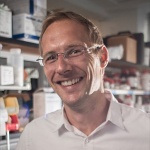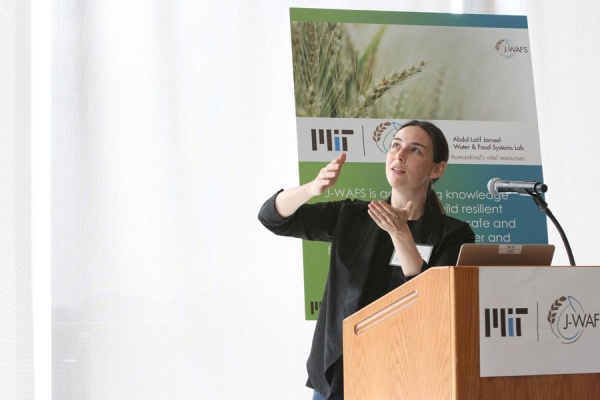Our Research Multifunctional light-diffusing fibers for simultaneous light management and fluid transport in microalgae bioreactors
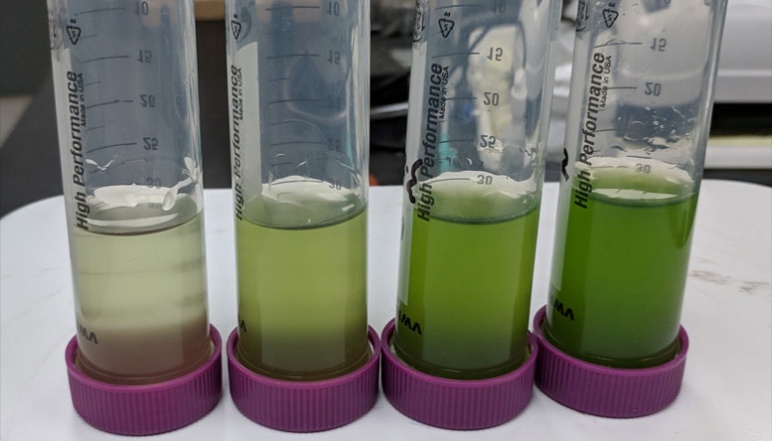
Samples of microalgae taken from leaky-light-guide-illuminated bubble column bioreactors after 0, 24, 48, and 72 hours of growth. Photo credit: Joseph Sandt
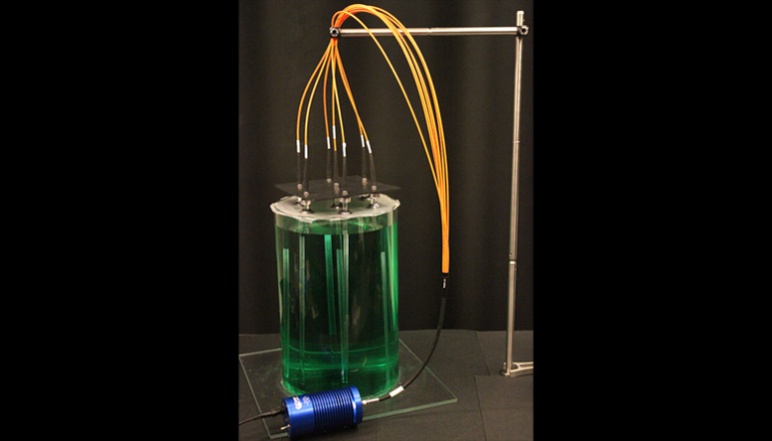
A mock-up of a bioreactor (with green dye to simulate the presence of algae), illuminated from within by seven leaky light guides powered by the pictured halogen lamp. Photo credit: Joseph Sandt

A mock-up of a bioreactor (with green dye to simulate the presence of algae), illuminated from within by seven leaky light guides powered by a halogen lamp. Overhead lighting is shut off to more clearly see the light in the “reactor” coming from the leaky light guides. Photo credit: Joseph Sandt
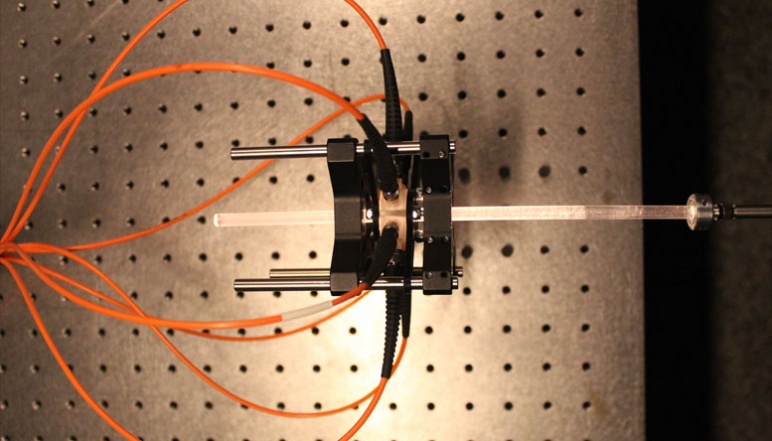
Device for characterizing the light emitted from leaky light guides along their length. Seven optical fibers in a bundle are fixed equally spaced around the sample, collecting emitted light and coupling it into a spectrometer at the other end of the fiber bundle. Photo credit: Joseph Sandt
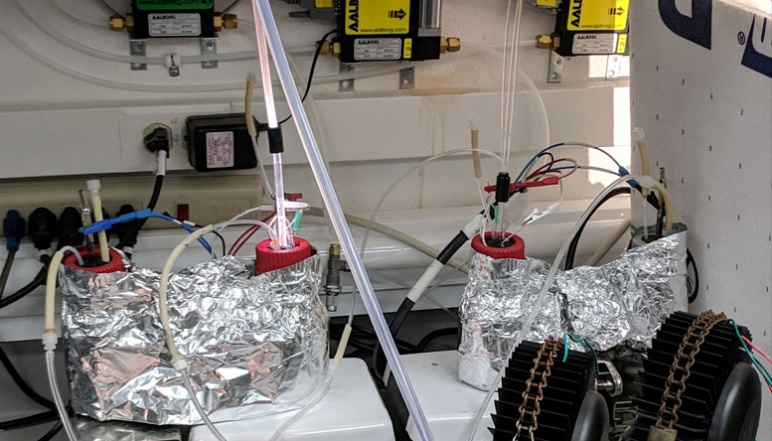
Depiction of the apparatus, at Arizona State University, for measuring the quantum efficiency of photosynthesis under varying lighting conditions by photoelectrochemistry. Foil wraps are to ensure that no external lighting influences the cells illuminated by leaky light guides. Photo credit: Joseph Sandt
Principal Investigator
Mathias Kolle
- Associate Professor
- Department of Mechanical Engineering
Mathias Kolle obtained his diploma in physics from the Saarland University, Germany, and the University of Lorraine, France in 2006. Subsequently, he received his PhD from the Cavendish Laboratories, University of Cambridge, UK in 2010. He worked as a postdoctoral researcher for Professor Joanna Aizenberg at the School of Engineering and Applied Sciences of Harvard University, and joined the faculty of the Massachusetts Institute of Technology (MIT) as an assistant professor in 2013. His research focuses on translating unique biological optical sensing, communication, and energy-conversion mechanisms into bioinspired, adaptive, and tunable micro-optical materials and devices.
Challenge:
Can engineered solutions for light and nutrient management in microalgae cultures help to produce algal biomass in a scalable, energy-efficient, affordable way in order to become a viable alternative source for food, feed, and biofuel?
Research Strategy
- Engineer leaky light guides to transport light and carbon dioxide efficiently throughout deep microalgae cultures
- Comprehensive modeling, prototype fabrication and testing of light management solutions in collaboration with experts on algae bio-reactors
Project description
Sustainable energy generation, food security, water management, and climate change are among the most critical global challenges of the 21st century. The generation of microalgae biomass is expected to become a key component in a viable portfolio of strategies aimed at securing fuel, food, and water for a world population that is expected to exceed nine billion people by 2050. Microalgae have several advantages over terrestrial crops. Cultivated on non-arable land they are orders of magnitude more efficient in the generation of biomass for biofuel, food, and feed than higher crops and simultaneously can also contribute to waste water treatment and carbon fixation. However, current algae farming approaches are not economically viable. A significant cost is attributed to the energy used for algae culture mixing, which ensures that all the microorganisms are exposed uniformly to sunlight and adequate carbon dioxide levels. In standard algae systems, the mixing energy ranges from 20% - 80% of the total energy demand in biomass generation, and still neither uniform sunlight exposure nor adequate CO2 level, which are both needed for maximum generation of photo-autotrophic biomass, are sufficiently well achieved. Many systems rely on additional CO2 sparging, an approach that wastes 50% or more of the concentrated gas, which is economically and ecologically highly unfavorable. In addition, mixing-induced variations in light exposure lower the phototropic algae’s productivity due to photoinhibition.
Recent research into the generation of food, feedstock, and biofuel using microalgae suggests that algae are orders of magnitude more efficient in the generation of usable biomass than higher crops. Systematic culturing of microalgae will therefore be one important component in a portfolio of strategies needed to ensure food and fuel security for a rapidly increasing world population. However, current efforts in culturing algae on an industrial scale are not yet economically viable. Major costs are associated with the energy needed for the actuation of large water masses in the culture volume to ensure adequate supply of light and carbon dioxide to the entire culture.
We aim to increase the productivity of industrial algae cultures by several orders of magnitude using multifunctional polymeric fibers that enable light level homogenization and adequate CO2 delivery throughout the entire algae culture via 100% efficient membrane transfer. Our approach will allow us to increase algae productivity in deeper culture volumes and simultaneously dramatically reduce the need for energy-intensive mixing. This goal can only be attained through fundamental research that centers on identifying promising light and CO2 supply strategies for industrial-scale algae cultivation (1), developing suitable material constituents and scalable, cost-efficient fiber fabrication strategies (2), and systematically assessing the impacts of the new CO2- and light-delivery methods on the physiology, ecology, and productivity of microalgal cultures (3).
This simple, energy-efficient means of ensuring homogeneous light distribution together with simultaneous delivery of carbon dioxide in dense, highly absorbing microalgae will help to achieve the full economic and social potential of algae cultures for food, feedstock, and biofuel generation. The fiber technology will form a platform for bioreactor and open pond designs that allow for significantly more efficient management of light and nutrient supply in microalgae cultures without the need of energy-intensive culture actuation.
Outcomes
- Determined that light-guiding acrylic rods could be modified using laser ablation in order to achieve customized light emission
- Achieved controlled microalgae growth in a bioreactor by using leaky light guides made of laser-modified acrylic rods fixed within columnar bioreactors
- Established that light guide technology can also be used as a photosynthetic light source for cyanobacteria in electrochemical cells
- Planned future steps to improve light distribution in deeper algae culture to improve the efficacy of biomass generation
News
Additional Details
Impact Areas
- Food
Research Themes
- Sustainability & Adaptation
- Transforming Food Systems
Year Funded
- 2017
Grant Type
- Seed Grant
Status
- Completed

